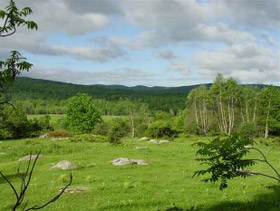How Cows (Grass-Fed Only) Could Save the Planet
On a farm in coastal Maine, a barn is going up. Right now it's little more than a concrete slab and some wooden beams, but when it's finished, the barn will provide winter shelter for up to six cows and a few head of sheep.
None of this would be remarkable if it weren't for the fact that the people building the barn are two of the most highly regarded organic-vegetable farmers in the country: Eliot Coleman wrote the bible of organic farming, The New Organic Grower, and Barbara Damrosch is the Washington Post's gardening columnist.
At a time when a growing number of environmental activists are calling for an end to eating meat, this veggie-centric power couple is beginning to raise it. "Why?" asks Coleman, tromping through the mud on his way toward a greenhouse bursting with December turnips. "Because I care about the fate of the planet."
Ever since the U.N. Food and Agriculture Organization released a 2006 report that attributed 18% of the world's man-made greenhouse-gas emissions to livestock — more, the report noted, than what's produced by transportation — livestock has taken an increasingly hard rap.
At first, it was just vegetarian groups that used the U.N.'s findings as evidence for the superiority of an all-plant diet. But since then, a broader range of environmentalists has taken up the cause.
At a recent European Parliament hearing titled "Global Warming and Food Policy: Less Meat = Less Heat," Rajendra Pachauri, chairman of the Intergovernmental Panel on Climate Change, argued that reducing meat consumption is a "simple, effective and short-term delivery measure in which everybody could contribute" to emissions reductions.
And of all the animals that humans eat, none are held more responsible for climate change than the ones that moo. Cows not only consume more energy-intensive feed than other livestock; they also produce more methane — a powerful greenhouse gas — than other animals do.
"If your primary concern is to curb emissions, you shouldn't be eating beef," says Nathan Pelletier, an ecological economist at Dalhousie University in Halifax, N.S., noting that cows produce 13 to 30 lb. of carbon dioxide per pound of meat.
So how can Coleman and Damrosch believe that adding livestock to their farm will help the planet? Cattleman Ridge Shinn has the answer.
Grass-Fed Beef and the Highland Breed
"Organic Beef" is produced in accordance with specific, written standards for organic production and is usually certified as such. No synthetic hormones, antibiotics or pesticides are permitted to be used. Nor can synthetic fertilizers or pesticides be used to produce the feed the animals consume. However, the animals may have been raised in a feedlot on organic grain, in which case they would contain the same unhealthy fats as conventional beef. There is very little quality differentiation between organic and conventional feedlot beef.
"Organic grass-fed" removes the feedlot aspect of the equation, but may still be a low-quality product if it was not properly finished. "Pasture-finished" beef means the animal was taken to a defined carcass finish point, such as Choice or Select grade, entirely on pasture. The finish point is defined by the amount of marbling in the meat and the flavor; a well-finished carcass is defined by its weight, age and fat content. Choice beef will have a good amount of marbling, while Select, a lower grade, has much more fat and lower-quality flavor. Prime is the highest grade for beef and often is sold to restaurants rather than grocery stores.
A pasture-finished steer that grades USDA Choice will have similar tenderness and juiciness to a feedlot steer finished at the same grade. The difference is a richer flavor in the pasture-finished beef along with the fact that the meat contains healthy fats. Lastly, "organic pasture-finished" beef (OPFB) offers hormone, antibiotic and pesticide-free guarantees, as well as healthy fats , in a single product.
Highland
The long-horned, mammoth-haired Highland takes first place as the oldest registered cattle breed, with a herd book initiated in 1884, about the same time they were imported into the United States. This beef animal could be the toughest breed out there. Centuries of surviving the rugged and often inhospitable environment of the Scottish Highlands have made these cattle practically impervious to cold weather, as well as resistant to disease. The Highland keeps better on marginal pasture than other cattle and will even dine on blackberries and other browse, all the while producing a lean and flavorful meat.
The Highland's shaggy coat comes in shades of red, black, dun, silvery-white and brindle. Its long forelock dangles across its eyes, offering protection from the sun and bugs-and creating one of the most adorable faces in the bovine world. Although those sweeping horns deserve cautious respect, these short-legged cattle are characterized as intelligent, trainable and laid-back. Cows weight about 1,100 pounds; bulls, 2,280 pounds.
